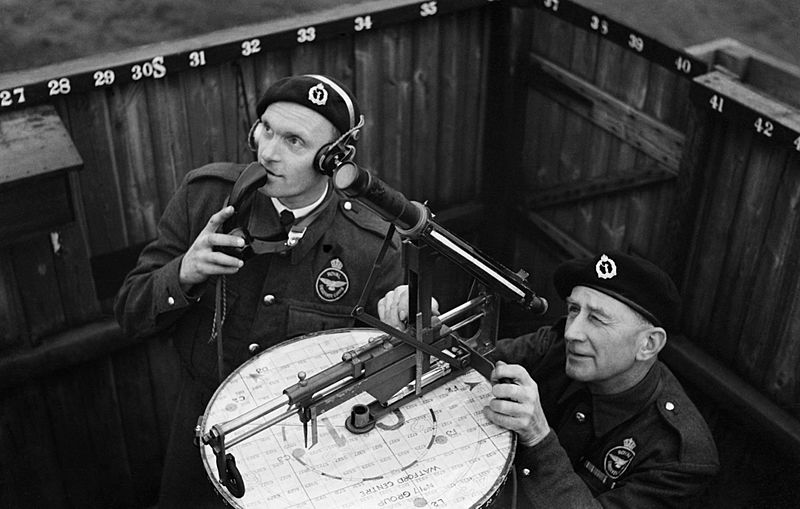Image: The Royal Observer Corps, 1939-1945. CH8215

Description: The Royal Observer Corps, 1939-1945. Using a chest telephone, Mr P C "Lofty" Austin, former commercial traveller and ex-professional footballer for Tottenham Hotspur, reports to the Corps Centre, as Mr E C "Smudge" Smith works the plotting instrument in a ROC post at Kings Langley, Hertfordshire. A number of details of the post and Post Instrument can be seen in this image and its basic operation described. The map on the Post Instrument shows the UK Grid Coordinate system for the area around the post. The entire instrument can be rotated around the vertical cylindrical shaft projecting (slightly) from the centre of the map. It rides on three wheels forming a triangle spanning the instrument; the forward wheel can be seen, but the two at the rear are covered by Smith's hands. The two light-colored rods running from the front wheel to the rear form a sliding surface along which the rest of the instrument can slide fore and aft. The main part of the instrument is the grey-coloured system riding on these rods. The dark-colored pin extending downward from the front of this part of the apparatus is the main pointer which the teller, Austin, would use to measure the location of the target. The pointer is currently indicating a location slightly outside the small grey disk on the map labeled "C3", in grid square 5925. Measurement is taken by rotating the assembly so it points in the general azimuth of the target, and then turning a knob on the right side of the sliding portion that moves the entire assembly fore or aft on a rack. This knob is only partially visible under the fingers of Smith's right hand. As the instrument moves, the telescope assembly on top rotates around the fixed point at the rear of the instrument, causing it to angle up (moving rearward) or down (forward) until it lies along the proper angle to point at the target. Once the telescope is properly aligned, the pointer is lying over the target's location over the ground as indicated on the map. On the map are markings for 11 Group and Watford Centre, the reporting chain this post is part of (Watford is a short distance to the southeast, 11 Group covered the Midlands). The large C1 centered on the map is the ID of this post. Four grey disks can also be seen on the map with markings for L2, F3?, C3 and C4. These indicate the location of other nearby posts, and were used with the Micklethwait Height Corrector to calculate the altitude of the aircraft. Arrows at the edges indicate the direction to two other posts, F2 and D3?, which are off the map area. The dashed ring on the map is the "sound line", used to estimate locations based on sound alone. The Micklethwait Height Corrector consists primarily of the two dark-coloured thin metal strips forming an L-shape under the telescope. As the telescope is raised and lowered, the lower of the two strips follows this motion and is read against a scale on the light-coloured strip running vertically along the side of the telescope's forward support. When indicated by their centre, the light-coloured cylinder at the bottom of the instrument, below the Corrector, is rotated to an indicated altitude. This causes the main sliding portion to move to account for the angle due to the altitude of the aircraft. The Observer, Smith, appears to be sighting along the iron sights on the top of the sighting unit, as opposed to using the telescope eyepiece. The walls of the post are printed with numbers representing 600ths of a circle, a short-lived measurement system that was later replaced with angular "mils", 400ths of a circle. Posts were normally manned by two, as in this case, but sometimes included a third who acted as a lookout and helper.
Title: The Royal Observer Corps, 1939-1945. CH8215
Credit: http://media.iwm.org.uk/iwm/mediaLib//53/media-53279/large.jpg This photograph CH 8215 comes from the collections of the Imperial War Museums.
Author: Bridge (P/O), Royal Air Force official photographer
Permission: This image was created and released by the Imperial War Museum on the IWM Non Commercial Licence. Photographs taken, or artworks created, by a member of the forces during their active service duties are covered by Crown Copyright provisions. Faithful reproductions may be reused under that licence, which is considered expired 50 years after their creation.
Usage Terms: Public domain
License: Public domain
Attribution Required?: No
Image usage
The following page links to this image:

